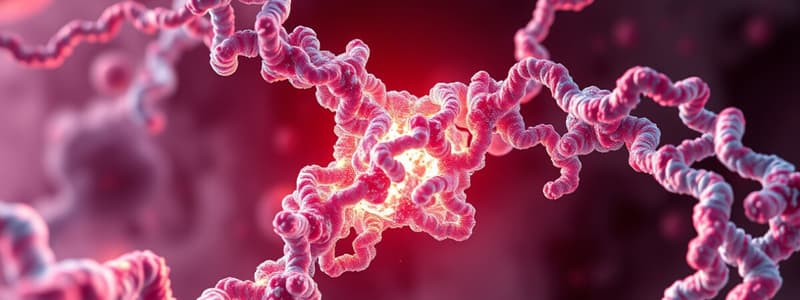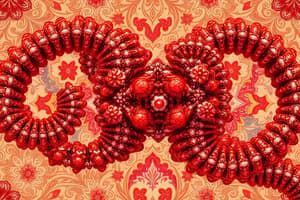Podcast
Questions and Answers
What best describes quaternary structure in proteins?
What best describes quaternary structure in proteins?
- It only occurs in enzymes and not in structural proteins.
- It refers only to the presence of disulfide bridges.
- It involves the folding of a single polypeptide chain.
- It describes interactions between individual polypeptide subunits. (correct)
Which statement is true regarding monosaccharides?
Which statement is true regarding monosaccharides?
- Monosaccharides consist only of glucose and fructose.
- All monosaccharides are linear and cannot cyclize.
- Monosaccharides are branched polymers of glucose.
- Monosaccharides can form hemi-acetals or hemi-ketals. (correct)
What are the primary components of starch?
What are the primary components of starch?
- It is composed of glucose and fructose.
- It consists of long chains of galactose units.
- It is formed from amino acids linked by peptide bonds.
- It is comprised mainly of glucose polymers. (correct)
Which of the following describes cellulose?
Which of the following describes cellulose?
Which condition can lead to protein denaturation?
Which condition can lead to protein denaturation?
What are the building blocks of DNA?
What are the building blocks of DNA?
Which of the following statements regarding RNA is correct?
Which of the following statements regarding RNA is correct?
What type of bonds connect the strands of DNA?
What type of bonds connect the strands of DNA?
Which of the following components is primarily responsible for the structure of cell membranes?
Which of the following components is primarily responsible for the structure of cell membranes?
Which type of fatty acid contains no double bonds?
Which type of fatty acid contains no double bonds?
What is the primary function of triglycerides in the body?
What is the primary function of triglycerides in the body?
How many hydrogen bonds form between adenine and thymine in DNA?
How many hydrogen bonds form between adenine and thymine in DNA?
What role does cholesterol play in cellular structures?
What role does cholesterol play in cellular structures?
Which statement is true about sphingolipids?
Which statement is true about sphingolipids?
What does a ΔG value of 0 indicate about a reaction?
What does a ΔG value of 0 indicate about a reaction?
How do catalysts affect the activation energy of a reaction?
How do catalysts affect the activation energy of a reaction?
Which of the following correctly identifies a characteristic of prostaglandins?
Which of the following correctly identifies a characteristic of prostaglandins?
Which statement about terpenes is correct?
Which statement about terpenes is correct?
What does a ΔH value greater than zero indicate in terms of spontaneity?
What does a ΔH value greater than zero indicate in terms of spontaneity?
What is the relationship between ΔG° and the equilibrium constant (Keq)?
What is the relationship between ΔG° and the equilibrium constant (Keq)?
Which of the following conditions indicates a reaction that is spontaneous at high temperatures?
Which of the following conditions indicates a reaction that is spontaneous at high temperatures?
What is formed when CO2 combines with ribulose-1,5-bisphosphate during carbon fixation?
What is formed when CO2 combines with ribulose-1,5-bisphosphate during carbon fixation?
How many cycles must the Calvin Cycle run to produce a single glucose molecule?
How many cycles must the Calvin Cycle run to produce a single glucose molecule?
What is the primary role of NADPH and ATP produced in the light-dependent reactions?
What is the primary role of NADPH and ATP produced in the light-dependent reactions?
What process is favored by higher concentrations of O2 in the leaf?
What process is favored by higher concentrations of O2 in the leaf?
Which of the following carbohydrates can glyceraldehyde-3-phosphate be used to synthesize?
Which of the following carbohydrates can glyceraldehyde-3-phosphate be used to synthesize?
What happens to the stomata of the leaves as temperatures rise?
What happens to the stomata of the leaves as temperatures rise?
Which enzyme catalyzes the process of carbon fixation and competes with photorespiration?
Which enzyme catalyzes the process of carbon fixation and competes with photorespiration?
What are plants called that fix carbon primarily through the Calvin Cycle?
What are plants called that fix carbon primarily through the Calvin Cycle?
What does the Michaelis constant (Km) indicate about substrate affinity?
What does the Michaelis constant (Km) indicate about substrate affinity?
Which statement accurately describes noncompetitive inhibition?
Which statement accurately describes noncompetitive inhibition?
Which feature is typical of prokaryotic cells?
Which feature is typical of prokaryotic cells?
In the lock and key model of enzyme action, what is true about the active site?
In the lock and key model of enzyme action, what is true about the active site?
What effect does competitive inhibition have on the enzyme kinetics?
What effect does competitive inhibition have on the enzyme kinetics?
Flashcards are hidden until you start studying
Study Notes
Quaternary Structure and Hemoglobin
- Multimeric proteins composed of multiple polypeptide chains, termed subunits.
- Interactions between subunits are classified under quaternary structure.
- Structural features include disulfide bridges, salt bridges, and intermolecular forces.
Protein Folding and Denaturation
- Protein folding occurs spontaneously but can be assisted by molecular chaperones.
- Denaturation can arise from changes in pH, high salt concentrations, organic solvents, or elevated temperatures.
Carbohydrates
- Monosaccharides are basic building units with the formula Cn(H2O)n, classified as aldoses or ketoses.
- Disaccharides are formed from two monosaccharides linked by glycosidic bonds (e.g., sucrose, lactose, maltose).
- Polysaccharides are long chains of monosaccharides, with examples including:
- Starch: energy storage in plants; consists of amylose (linear, α-(1-4) bonds) and amylopectin (branched).
- Glycogen: branched polymer for energy storage in muscles and liver.
- Cellulose: linear structure provides rigidity to plant cell walls (β-(1-4) bonds).
- Chitin: forms structure in fungal cell walls and insect exoskeletons (β-(1-4) bonds).
Nucleic Acids
- DNA: Deoxyribonucleic acid, composed of nucleosides (sugar + base) and nucleotides (sugar + base + phosphate).
- RNA: Ribonucleic acid, similar structure with ribose and uracil instead of thymine.
- DNA exhibits a right-handed double helix structure with antiparallel strands connected by hydrogen bonds.
- Key base pairs: A-T (2 hydrogen bonds) and G-C (3 hydrogen bonds).
Lipids
- Lipids are hydrophobic and low in polarity; crucial types include:
- Triglycerides: energy storage, insulation.
- Phospholipids: structural components of cell membranes.
- Cholesterol: membrane fluidity and precursor for steroid hormones.
- Steroids: hormones with various biological functions.
- Sphingolipids: diverse roles in nervous system.
- Prostaglandins: chemical messengers involved in various physiological responses.
- Terpenes: synthesized from isoprene units, vital for plant functions and precursor to essential compounds.
Thermodynamics and Kinetics
- Gibbs Free Energy (ΔG) indicates the energy available for work:
- ΔG < 0: spontaneous (exergonic).
- ΔG > 0: nonspontaneous (endergonic).
- ΔG = 0: system at equilibrium.
- Conditions for spontaneity depend on enthalpy (ΔH) and entropy (ΔS).
- Equilibrium constant (Keq) influences reaction direction; ΔG° relates to Keq by the equation ΔG° = -RT ln Keq.
Enzyme Kinetics
- Catalysts speed up reactions, lower activation energy, and are not consumed; they do not shift equilibrium.
- Lock and Key vs. Induced Fit models illustrate substrate-enzyme interactions.
- Michaelis-Menten kinetics defines reaction rates and substrate affinity via the equation V = Vmax [S] / (Km + [S]).
- Competitive inhibition increases Km while Vmax remains unchanged. Noncompetitive inhibition decreases Vmax without affecting Km.
Cell Structure and Cellular Processes
- Prokaryotes lack a nucleus and membrane-bound organelles, and they reproduce via fission.
- Eukaryotes have membrane-bound nuclei and organelles; reproduction occurs through mitosis.
- NADPH and ATP from light-dependent reactions drive the Calvin Cycle, converting CO2 into sugars like glyceraldehyde-3-phosphate.
- Key steps of the Calvin Cycle include carbon fixation, reduction, and regeneration, requiring multiple cycles to produce glucose.
- Photorespiration competes with the Calvin Cycle, with higher CO2 favoring carbon fixation and higher O2 leading to inefficiency under stress conditions.
C4 Photosynthesis
- C3 plants utilize the Calvin Cycle exclusively for carbon fixation, producing 3-phosphoglycerate as the primary product.
Studying That Suits You
Use AI to generate personalized quizzes and flashcards to suit your learning preferences.




